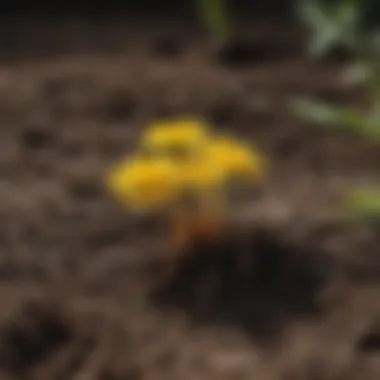Effective Strategies for Dandelion Control in Lawns


Intro
Dandelions are a common sight in many lawns. Their bright yellow flowers and fluffy seed heads are often seen as charming, but for homeowners, these plants can quickly become a nuisance. This article explores effective methods for dealing with dandelions, considering both chemical and organic approaches to removal. Understanding the biology of dandelions and their growth patterns is crucial for successful elimination and prevention. By employing the strategies discussed here, you can maintain a healthy, attractive lawn while reducing the presence of these persistent weeds.
Key Insights and Trends
In the realm of lawn care, there have been notable shifts in focus toward more natural and sustainable practices for weed management. Homeowners seek a balance between effective dandelion control and environmental responsibility. Current trends reflect a growing preference for organic solutions over synthetic chemicals, aligning with broader movements toward eco-friendly gardening.
Popular Gardening Techniques
Several gardening techniques are gaining traction as homeowners aim to improve their landscapes:
- Mulching: Applying organic materials like wood chips or straw can inhibit dandelion growth by blocking sunlight.
- Seedling Control: Some gardeners focus on nurturing strong grass growth to outcompete unwanted weeds.
- Manual Removal: Hand-pulling is gaining popularity due to its non-toxic nature and effectiveness when done correctly.
Regular care coupled with these techniques can lead to a healthier lawn ecosystem, which in turn reduces the likelihood of dandelion infestations.
"Sustainable practices not only enhance the beauty of outdoor spaces but foster a balanced ecosystem where all plants can thrive."
Practical Tips and How-To Guides
When it comes to dandelion management, various methods can be employed to suit different preferences and situations. Here are some practical guides:
Step-by-Step Guides for Dandelion Control
- Identify the Problem: First, assess the extent of the dandelion infestation. This will help inform your approach.
- Manual Removal:
- Chemical Treatments:
- Preventative Measures:
- Evaluate and Adjust: After implementing your chosen method, monitor your lawn for new dandelion growth and adjust your strategy as needed.
- Use a weeding tool or your hands to remove dandelions.
- Ensure you remove the entire root to prevent regrowth.
- Early spring is typically the best times for effective hand-pulling.
- If you opt for herbicides, choose a selective herbicide that targets dandelions without harming other plants.
- Carefully follow the product instructions to minimize harm to the surrounding ecosystem.
- Regularly mowing your lawn can prevent dandelions from flowering and seeding, thus controlling their spread.
- Maintain proper lawn health through adequate watering, fertilization, and aeration to encourage dense grass growth.
Incorporating these insightful techniques will empower homeowners to reclaim their lawns from dandelions while fostering a vibrant environment that appreciates nature's beauty.
Preamble to Dandelions
Dandelions, often dismissed as mere weeds, hold an important place in the ecosystem. Understanding this plant is essential for homeowners and gardening enthusiasts. Dandelions are resilient and can thrive in various conditions. They are characterized by their bright yellow flowers that eventually turn into fluffy seed heads. This article aims to explore their nature and impact, providing useful insights for those looking to maintain their lawn.
The Nature of Dandelions
Dandelions belong to the Taraxacum genus and are known for their distinctive features. The plant has a deep taproot, which allows it to draw nutrients from the soil. This root can grow several inches deep, making dandelions challenging to remove completely. Dandelions are perennials, which means they can return year after year unless effectively managed. Their flowering cycle often leads to rapid propagation. A single dandelion can produce up to 15,000 seeds, which are easily distributed by wind. Understanding this biology is vital, as it underscores the importance of timely intervention when dealing with dandelions.
Impact on Lawn Aesthetics
The presence of dandelions can have a notable influence on the overall look of a lawn. For many homeowners, a pristine green lawn is a source of pride. Dandelions, with their bright yellow color, can disrupt the uniformity of turf grass. While some may appreciate their aesthetic appeal, most consider them a nuisance. Their ability to spread quickly can result in a lawn that looks unkempt. This perception is crucial for homeowners, as a well-maintained yard can enhance property values. Moreover, dandelions can compete with grass for nutrients and water, ultimately affecting the health of your lawn. Understanding these implications is essential for creating a visually appealing outdoor space.
Understanding Dandelion Growth
Understanding the growth patterns of dandelions is critical in developing effective strategies for their management and removal. Dandelions are persistent weeds that thrive in a variety of climate conditions. By grasping the factors that contribute to their life cycle and growth, homeowners can employ targeted methods to reduce their presence in lawns. This section focuses on two primary elements: the life cycle of dandelions and the conditions favoring their growth.
Life Cycle of Dandelions
Dandelions possess a unique life cycle that includes four main stages: germination, growth, flowering, and seed dispersal. Each stage offers specific insights on how to combat their spread.
- Germination: This phase occurs when seeds, often spread by wind, find favorable soil conditions. Dandelion seeds can germinate at any time during the growing season, provided moisture is present.
- Growth: Once germinated, dandelions grow rapidly. Their deep taproots allow them to access nutrients and water from deeper soil layers. This makes them resilient against drought.
- Flowering: The bright yellow flowers appear shortly after growth. This stage attracts pollinators but also signifies the start of seed production. Each flower head can produce dozens of seeds.
- Seed Dispersal: Dandelion seeds are lightweight and easily carried by the wind. This ability facilitates rapid colonization of new areas.
Regular monitoring of the lawn to catch dandelions early in their life cycle can significantly reduce future infestations.
The understanding of these stages helps homeowners decide when to take action. For effective control, targeting the plants before they flower and produce seeds is paramount. This approach reduces the number of new plants that can sprout in the following seasons.
Conditions Favoring Growth


Several environmental conditions support the growth of dandelions, making it essential for homeowners to know what they are.
- Soil Compaction: Dandelions thrive in compacted soil, which often leads to poor grass growth. Compacted soil allows dandelions to establish their deep roots more easily.
- Poor Lawn Care: Lawns that are not maintained through proper mowing, fertilizing, and aerating tend to be more prone to dandelion infestations. Weeds such as dandelions take advantage of nutrient imbalances.
- Moisture Availability: Dandelions require moisture, and areas with high water retention can see an increase in their populations.
- Full Sunlight: Dandelions prefer full sun but can adapt to partial shade. Areas that receive a lot of sunlight are more likely to support their growth successfully.
Homeowners should consider these factors when planning lawn care strategies. Reducing soil compaction through aeration, ensuring proper watering practices, and maintaining lawn health will contribute significantly to minimizing dandelion growth.
Manual Methods of Removal
Manual methods of removing dandelions offer a sustainable approach to lawn care. These techniques emphasize physical removal rather than relying on chemicals. This is essential for homeowners who wish to maintain a safe environment for pets and children. Furthermore, manual methods can provide immediate results and help prevent further infestation if done correctly.
Hand Pulling Techniques
Best Timing for Hand Pulling
Hand pulling is most effective when the soil is moist. This typically occurs after rainfall or during early morning hours when dew is present. The key characteristic of this timing relates to ease; wet soil allows for easier extraction of the entire root. Successfully pulling dandelions at the right moment can minimize the chance of regrowth.
However, there are some disadvantages. For instance, pulling during dry conditions can break the taproot. This leads to partial removal, allowing the dandelion to thrive and grow back even stronger. Thus, it is crucial to pay attention to soil moisture content when engaging in this method.
Tools for Efficient Removal
Using specific tools enhances the effectiveness of hand pulling. Common tools include weeding forks, trowels, and specialized weeding tools designed to target dandelions. The key characteristic of these tools lies in their design; they allow for more precision when removing deep taproots.
Furthermore, the unique feature of using weeding tools is their ability to save time and energy. They can make the actual removal process faster and reduce the physical strain often associated with manual pulling methods. However, if not used correctly, these tools can damage surrounding grass or plants, creating unwanted disruption in your lawn.
Using Weeding Tools
Types of Weeding Tools
There are various types of weeding tools on the market, each serving a unique purpose. Optimal choices for dandelion removal include dandelion diggers, hand hoes, and knives. The variation presents options depending on personal preference and the scale of the invasion.
This diversity is beneficial because it allows homeowners to select a tool suited for the specific task. For example, a dandelion digger effectively removes entire taproots, while a hand hoe may be useful for clearing superficial weeds. Despite their advantages, care must be taken when using these tools to avoid harming desirable plants in the lawn.
Proper Usage Techniques
Understanding how to use these weeding tools correctly is critical. Improper technique can lead to ineffective removal or damage to the lawn. The unique feature of proper usage techniques involves angling the tool towards the weed's root system for optimal extraction.
Moreover, utilizing a steady pull can help to ensure that you’re removing the entire weed, root and all. This technique is popular among gardeners and destroys the weeds while maintaining the health of surrounding grass. However, using inappropriate force can lead to tearing the top and leaving roots behind, resulting in further growth later on.
Chemical Approaches to Dandelion Control
Chemical approaches to dandelion control are essential for homeowners who wish to manage these resilient weeds effectively. Utilizing herbicides offers a quick solution to removing dandelions without the exhaustive effort that manual methods require. Understanding the distinctions between different herbicide types, as well as adhering to proper application guidelines, ensures effective control and helps protect other plants in your garden. It is imperative to appreciate both the benefits and safety considerations involved with these chemical agents to mitigate potential negative impacts on your lawn ecosystem.
Herbicides: An Overview
When considering herbicides for dandelion control, one must understand the difference between selective and non-selective herbicides.
Selective vs. Non-Selective Herbicides
Selective herbicides aim to target specific weed types, allowing grass and other desirable plants to thrive. This targeted approach minimizes damage to your lawn and is a beneficial choice for maintaining overall lawn health. On the other hand, non-selective herbicides affect all plants in the application area, which may lead to unwanted damage to your desired flora.
Key Characteristics: - Selective herbicides, such as 2,4-D, specifically eliminate dandelions while preserving the surrounding grass.
Advantages: - The primary advantage of using selective herbicides is their efficiency in eradicating weeds while protecting the lawn.
Disadvantages: - Non-selective herbicides should be used cautiously, as their broad action may wreak havoc on your entire garden decoration.
Application Guidelines
Applying herbicides correctly is vital for achieving desired results while preventing harm to non-target species. Broadly, there are general guidelines to follow.
Key Characteristics: - Always read the label instructions carefully to understand the specific application rates and conditions.
Unique Features: - Favorable environmental conditions, such as windless days, enhance the likelihood of the herbicide effectively targeting dandelions without drift.


Advantages: - Adhering to application guidelines helps ensure safety for the applicator and other nearby plants.
Disadvantages: - Improper application might lead to less effective control or undesired effects on surrounding vegetation.
Safety Considerations
Safety considerations in chemical application are paramount to protect both the person applying the herbicide and the surrounding environment. Homeowners need to be diligent in employing practices that safeguard non-target plants and observe the broader environmental impacts of their actions.
Protecting Non-Target Plants
Protecting non-target plants during herbicide application is critical to maintaining the overall health of your garden. Using shields or strategically applying herbicides can minimize unintended exposure.
Key Characteristics: - Options like spot treatment allow for targeted applications that can spare surrounding flora.
Advantages: - This approach fosters a healthier ecosystem while effectively controlling dandelion growth.
Disadvantages: - However, if not done carefully, overspray can result in collateral damage to desirable plants.
Understanding Environmental Impact
Understanding the environmental impact of using herbicides is equally important. Many herbicides can contaminate soil and water sources, potentially causing long-term harm to local ecosystems.
Key Characteristics: - Many herbicides contain chemicals that can persist in the environment, creating adverse effects long after application.
Advantages: - Learning about these impacts allows homeowners to make informed choices regarding their weed control methods, opting for safer alternatives when possible.
Disadvantages: - Ignoring these consequences might lead to broader ecological issues, affecting pollinators and beneficial insects.
It is crucial to engage in responsible application practices, ensuring that you prioritize the health of your lawn and its surrounding environment.
Organic and Natural Solutions
Organic and natural solutions for clearing dandelions hold significant importance for homeowners who seek eco-friendly methods. These approaches not only help eliminate the unwanted plants but also promote a healthier lawn ecosystem. Many of these methods do not rely on synthetic chemicals, making them safer for pets, children, and the environment. Additionally, they contribute to sustainable gardening practices that reduce the ecological impact of lawn care.
Utilizing organic and natural methods can also enhance the aesthetic value of your lawn. They work to strengthen the soil health, which in turn encourages the growth of desirable plants. Furthermore, these solutions can be cost-effective and easily accessible. Options like vinegar, salt, boiling water, and proper mulching techniques provide homeowners with practical tools to manage dandelion infestations while improving lawn vitality.
In following sections, we will explore specific organic and natural solutions. Each method carries its unique advantages and some considerations to keep in mind. The aim is to offer a comprehensive insight into how these methods can be effectively applied in everyday lawn care.
Vinegar and Salt Solutions
Vinegar and salt are common household items that can serve as powerful tools for tackling dandelions. The acetic acid in vinegar acts as a non-selective herbicide, which means it can kill any green plant that it touches. Therefore, it is crucial to apply it directly to the dandelions and avoid surrounding plants. Mixing vinegar with salt enhances this effect by dehydrating the weeds.
Preparation Steps:
- Mix equal parts vinegar (at least 10% acetic acid) and salt in a spray bottle.
- Add a few drops of dish soap to help the solution adhere to the plant leaves.
- Shake well to ensure all ingredients are combined.
It is recommended to apply this solution on a sunny day, as the heat helps to maximize its effectiveness. Bear in mind that repeated applications may be necessary for stubborn dandelions. While effective, this method can also affect surrounding vegetation, so use carefully.
Boiling Water Method
Another straightforward yet effective solution is the boiling water method. This technique leverages simple heat to destroy the plants. Pouring boiling water directly onto dandelion roots can kill them almost instantly, preventing them from regrowing.
Application Steps:
- Boil a pot of water until it reaches a rolling boil.
- Carefully pour the boiling water over the dandelions, ensuring you target the root directly.
- Monitor the area, as this method is entirely non-selective and can affect other plants nearby.
The boiling water method is especially effective in heavily infested areas where other methods may take time to show results.
Mulching Techniques
Mulching is another effective strategy for preventing dandelion growth sustainably. By covering the soil with a layer of organic material, typically wood chips or straw, you can reduce sunlight access to the dandelions and other weeds. This method not only suppresses their growth but also maintains soil moisture.
Benefits of Mulching:


- Blocks sunlight, preventing dandelion seeds from germinating.
- Improves soil health by adding organic matter as it breaks down.
- Reduces the need for watering by retaining moisture in the soil.
To implement mulching:
- Clear the area of existing weeds, if any.
- Apply a layer of mulch 3 to 4 inches thick.
- Replenish the mulch annually for continuous effectiveness.
Mulching combines functionality and aesthetics, creating a neat appearance while combatting dandelions effectively. By adopting these organic and natural methods, homeowners can effectively turn their battle against dandelions into a proactive lawn care strategy.
Preventing Future Dandelion Infestations
Preventing future dandelion infestations is crucial for maintaining a healthy and aesthetically pleasing lawn. By addressing the root causes of dandelion growth, homeowners can reduce the likelihood of these persistent weeds taking hold. The importance of proactive strategies cannot be overstated, as they minimize the time and resources spent on removal while promoting a lush lawn that thrives.
One effective approach involves enhancing lawn health through proper mowing, fertilization, and aeration. This ensures that grass remains strong, healthy, and better able to compete with dandelions and other weeds. Additionally, the implementation of ground covers can effectively suppress dandelion seeds from germinating, creating a natural barrier.
Maintaining Lawn Health
Good lawn health is the foundation for preventing dandelion infestations. It includes a set of practices designed to strengthen grass growth and limit weed competition.
Proper Mowing Practices
Proper mowing practices play a vital role in lawn health. Keeping grass at the right height encourages root development and reduces stress during dry periods. Ideally, grass should be cut at a height of about three to four inches. This height allows for deeper root systems and competition against weed growth.
One key characteristic is that mowing too short can weaken grass and make it more susceptible to weed invasions. Instead of a beneficial choice, this can lead to a cycle of more weeds, including dandelions. Therefore, maintaining the right height is essential for the long-term health of the lawn.
Another unique feature of proper mowing is the regularity of the practice. Frequent mowing can prevent dandelions from flowering and seeding, essentially breaking their life cycle. One disadvantage of neglecting this practice is that it can provide an environment for dandelion seeds to thrive, leading to larger infestations.
Fertilization and Aeration
Fertilization and aeration significantly contribute to preventing dandelion growth. Fertilization restores essential nutrients to the soil, promoting robust grass growth. Strong grass can better withstand competition from dandelions, making this practice essential.
A key characteristic of fertilization is the timing, usually done in early spring and fall. This approach encourages healthy growth patterns aligned with the grass's natural cycles. Organic options, like compost, are also popular as they improve soil health without harming the environment.
Aeration allows for better air exchange and nutrient absorption, which benefits the overall lawn ecosystem. A unique feature is that aerating compacted soil can reduce water pooling, thus promoting effective drainage. Yet, a downside to over-fertilizing can be increased vulnerability to weeds, including dandelions, especially when proper balance is not maintained.
Using Ground Covers
Using ground covers effectively prevents dandelion growth by providing a natural barrier. These plants spread quickly and occupy space, which limits the germination and establishment of dandelion seeds. Ground covers can be selected based on their compatibility with the existing ecosystem and aesthetic preferences. Some popular options include creeping thyme or clover. These plant choices not only enhance visual appeal but also contribute to soil health.
In summary, prioritizing lawn health through proper mowing, fertilization, and ground cover use is essential for maintaining a dandelion-free environment. These preventative strategies offer an efficient approach to managing lawn aesthetics and overall health.
"An ounce of prevention is worth a pound of cure."
By committing to these methods, homeowners can enjoy a vibrant lawn while minimizing the ongoing struggle with dandelions.
Culmination
In this article, we covered essential methods for effectively managing dandelions on your lawn. The presence of dandelions is not just an aesthetic issue; it can indicate underlying problems in lawn health. Taking action against these weeds is crucial for maintaining the overall appearance of your outdoor space and ensuring the vitality of your grass.
Recap of Methods
We explored a variety of strategies divided into several categories:
- Manual Methods: Hand pulling and tool usage promote engagement with your lawn, allowing homeowners to target dandelions directly.
- Chemical Approaches: Herbicides offer a more powerful solution for large infestations.
- Organic Solutions: Natural methods like vinegar, salt, and boiling water can minimize chemical use.
- Preventative Measures: Keeping your lawn healthy is key.
- Best Timing for Hand Pulling: Early morning is ideal when soil is moist.
- Using Weeding Tools: Tools like dandelion pullers can make the task easier and more efficient.
- Selective vs. Non-Selective Herbicides: Understanding the difference ensures protection of desired plants.
- Application Guidelines: Follow manufacturer instructions for best results.
- Mulching Techniques: This preventative measure suppresses growth of new weeds.
- Proper Mowing Practices: Mow regularly to maintain optimal lawn health.
- Ground Covers: These can deter dandelion growth effectively.
Each method presents its own benefits and obstacles, often depending on the specific situation of the lawn.
Final Thoughts on Lawn Management
Lawn management is an ongoing task, influenced by seasonal changes and environmental factors. A healthy lawn not only improves the landscape but also contributes to an ecosystem that limits weed growth, including dandelions. The integration of mechanical, chemical, and organic methods gives homeowners varied options to suit their preferences and principles.
Ultimately, the goal is to create an outdoor space that is both pleasing and sustainable. Regular maintenance and a proactive approach will ensure that dandelions remain under control, preventing them from overshadowing the beauty of your lawn.



